Stratasys Supports To Transform Indian Manufacturing: Rajiv Bajaj
- By 0
- February 04, 2020
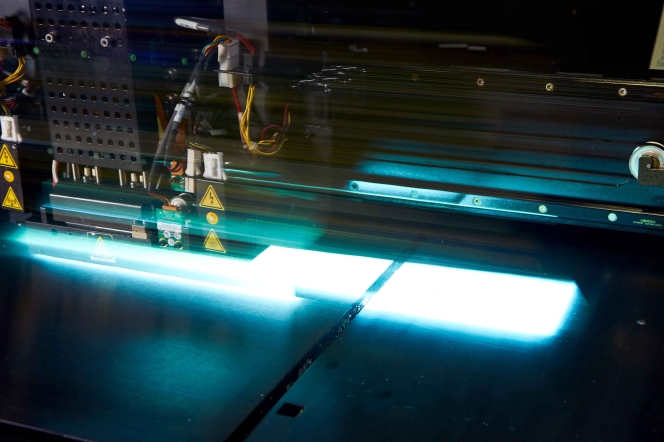
Stratasys, a global leader in additive manufacturing or 3D printing technology, helps Indian aerospace, automotive, healthcare and consumer products industries design and make prototypes, manufacturing tools, and production parts faster and cost effectively.
Several OEMs and Tier-1 companies in these industry segments are its customers who want high value products at very reasonable prices. In an interaction with T Murrali of this publication, Rajiv Bajaj, Managing Director, Stratasys India and South East Asia, said, “We are changing the game by giving industrial production-grade machines at affordable prices. We have a lot of takers for them across industries in the Tier-2& 3 cities also.” Edited excerpts:
Q: In India, is additive manufacturing still confined to R&D for making prototypes? What is the next step in the automotive sector?
Bajaj: The car companies we have in India are globally competitive, keeping pace with what is happening around the world. The differentiation we see as a technology provider is the level of technology adoption by the local OEMs. Similar-sized OEMs elsewhere in the world will have a series of our machines whereas in India they are just 1 or 2 each, most of them with the auto OEMs. It also has to do with the technology adoption rate and the trend of product development and differentiation which came in rather late.
Secondly, prototyping is a well documented area; people use it day in and day out. Companies like Honda, that do only manufacturing in India, are adopting it for their jigs and fixtures. The third stage we look at is personalisation where one can use the 3D printed part in a portion of the vehicle, which has been done with BMW MINI, and Daihatsu in Japan. We don’t have any use case in India as yet. We are looking at possibilities here.
Q: Are there some applications where it can be used?
Bajaj: Now we are talking about not just back-end or R&D use but actual customer experience. There we are giving tooled-up parts with multiple finishes. There are finite possibilities with the new numbers and quality of parts being manufactured. 3D is also used as a marketing tool. Typically, people look at it as a device to save money or time as this is a revenue generation tool.
Q: So even if you make 10,000 parts, each one can be customised?
Bajaj: Yes, absolutely; it’s mass customisation.
Q: Do you see opportunity globally and in India to replace traditional manufacturing by 3D, and to what extent?
Bajaj: There is no simple yes or no answer to this. It involves a deep understanding of how the two processes work. If volumes are a few thousands, yes; but if it is in lakhs, then maybe not. The most intelligent organisations would be the ones who would use a mix-and-match of this technology. Additive doesn’t mean it should remove subtractive. Intelligence lies in knowing when to use additive and where to leverage subtractive, and vice-versa. Combining these two will make for a very efficient organisation.
Q: Will this find a key role in low volume parts?
Bajaj: Yes, as well as complicated parts and in the aftermarket for different models. Even enthusiasts like Jay Leno will find a use for this. In fact Leno has bought a 3D printer from Stratasys to make parts for his collection of vintage cars. It’s a useful tool for motor enthusiasts to make parts that are not available in the market.
Q: Do you see additive manufacturing for lightweighting?
Bajaj: Parts consolidation is a very direct outcome of 3D printing because, for example, it can print a chain with interlock whereas in the traditional process each part would be a separate entity. In an aerospace part we consolidated some 100 plus parts into one unit. In automotive, now many areas for this are emerging for limited production; mass production would take some more time but it will come. When we talk of lightweighting, making prototypes earlier was quite difficult but today with this technology we can make very complex prototypes and validate the design. Once it is validated it can use any method: for low volume additive, for high volume something else. That’s the advantage. Also, in assembly, we can check minute gaps in the line very accurately. Changes in tooling can be done immediately instead of waiting for a long period as customisation has to be done in the shortest period possible.
Q: Would this help reduce the number of iterations?
Bajaj: Actually I can do more iteration by trying out newer ideas. This will help enhance the quality level at the design stage itself. We have to find a balance between the additive and the subtractive.
Q: Would the customer complaints reduce when you make a product faster?
Bajaj: Obviously, as I am designing quality into the process and product from day one; it helps me take informed decisions. Basically, what the customer wants is a good, tangible product.
Q: What is the response you get from customers who have not taken up this technology as yet?
Bajaj: In today’s scenario there would be very few customers in the automotive supply chain who have not experimented with 3D printing. If they are not using it directly they are getting services done outside. The expectations from customers is different; some want better quality, some want it faster, some cheaper and so on. Most of them are experimenting so that this should become a part of their process.
Q: Are there other concerns than cost?
Bajaj: In India, cost is a big concern; customers want high value at the most reasonable price; they are not looking just for low cost. So there is pressure; that’s why a lot of innovation helps. A company cannot just copy paste; it has to innovate. In 2015 our lowest cost of the printer in FDM series was around INR 60 lakh. Today, we have given the same technology on a different platform for INR 15 lakh. That’s how we are changing the game, giving the same class of industrial production grade machines at an affordable price. This has found a lot of takers for us in the Tier-2&3 cities, not just automotive but across industries.
Q: There might be apprehension among your potential customers that if they buy a machine from you they would have to be wedded forever to your company to get the material. Is that true or will they be free to choose their own material from the market for use?
Bajaj: For most of our technologies it is true but we are working on a new technology called SLA which is our only platform where the consumer can buy material elsewhere. The problems with 3D printing are many. Let us say if you make your material open and then the customer comes and says the parts are not printing correctly; then where do you fix the blame? That becomes a big problem. The reason why we keep it to us is not because we want to charge customers more, but because we want to give them 100 percent accurate results all the time. Predictability and repeatability are problems that 3D printers at entry level are facing every day. By controlling the oven temperature and the material properties we are able to achieve 100 percent accuracy. When companies like Maruti tell us there are some challenges, we work with them to sort it out.
It is like when the customer buys a car and goes to the spurious market to get parts. When the vehicle fails they come and complain to us. We check the car and tell them the company is not responsible for whatever parts the customer fits in. Even insurance companies do not entertain such claims. If you want consistent quality and most desirable product performance you will have to stick to some standards.
Q: Do you see Stratasys to become even a supplier to vehicle manufacturers or Tier-1s?
Bajaj: It is not done in India as yet but globally we do run Service Bureaus. The BMW MINI project is all done by our Bureaus.
Q: Is this like software as a service where they can use your facility?
Bajaj: Yes, they have to just give us the software data and we will be able to print it. But that is not the real intelligence of the service bureau. The services we provide are very high-end; redesigning the entire thing, adding more colour variants, giving a new look to the car. These are the kind of services we provide where 3D printing is a part of the process. We take into account all the special requirements the customer wants. We have done complex projects in India and our overseas offices as a service.
Q: Which are the markets that are very attractive, where you have more inroads as of now? Going forward, how will it be?
Bajaj: Automotive is our sweet spot, globally (around 25 percent) and in India (30 percent). I see it as a major place for expansion because compared to global standards the technology adoption with these companies is very low. I believe if they have to compete in testing times like this there is no other way than to come out with products faster and cheaper. Technologies like Stratasys 3D printing are tailor-made for this. Despite the slowdown we are very bullish about the automotive market because of the lack of penetration in it. It’s a technology life cycle, similar to the software industry where the cycle came from the US and went on to Europe and to Asia before coming to India.
Q: How do you compare with aviation as you are the only one certified by the aviation industry?
Bajaj: For aviation, we are limited to plastics at this point in time so the parts made by us are more suitable for the cabin interior. India is more about defence aviation where the aircraft interior is not that critical. While HAL, DRDL, etc are all using our technology, mass proliferation would occur when companies like Boeing and Airbus have their complete setup in India. We need civil aircraft to be manufactured in India to see that kind of growth; there are none at present.
Q: For automotive, what are the key drivers of growth globally and in India?
Bajaj: One is the quest for innovation through rapid prototyping. Two, the product development cycle time has reduced by 50 percent in the last four years. If a new platform time was 3 years earlier, today it is under 18 months. In the past two years, any automotive company that has not come up with newer models at a faster pace has not survived. To keep the momentum going in the market they have to come up with new products. If they have the right product at the right price in India their business will certainly grow. (MT)
BOX
User Forum
The 3rd edition of Stratasys India User Forum in Bengaluru recently had participation from over 620 industry leaders and end-users. Organised by Stratasys, a global leader in 3D printing and Additive Manufacturing (AM), the Forum was a platform for professionals to exchange views on the latest 3D printing trends, applications, and the best practices across key sectors in India.
Michael Agam, President, South Asia, Stratasys, said the User Forum brought together several leading brands such as Maruti Suzuki, Ashok Leyland and Honda Cars in the Indian ecosystem, that have used Stratasys’ products to innovate. This reiterates why India is a key market for the company.
Saurabh Singh, Head of Design Studio at Maruti Suzuki India Ltd, highlighted how the brand has been able to leverage 3D printing to provide high quality, ergonomically suited and distinctly personalized offerings, thereby enhancing the overall customer experience.
Sundaresan, Vice-President, Electric Vehicles and eMobility Solutions, Ashok Leyland, said that AM helped the company save about 14,138 days of hour-utilization and nearly INR 74 lakh in manufacturing costs. He said Ashok Leyland made clutch housing using AM to carry out fitment checks and it helped to contain the time to three days against close to 60 days in the conventional method. AM helped also to keep the time schedules for the development of blower cover and meet the CMVR regulations. The company made prototypes and parts for the initial production lot. The whole exercise was completed in a couple of days as compared to 90 days in the conventional method. Similarly, the three-axis intake pipe was made in a day as opposed to the usual three months. It also made a scaled concept of the seven-speed gearbox having geometric complexity. For electric vehicles the company made traction motor stator sector in AM, which helped in physically measuring the slot-fill, evaluate ease of winding and measure external portions of end-winding. “For smaller volumes also AM is economical. For advanced mobility it plays a key role in the combustion chamber”, Sundaresan added.
Bhushan Chandna, Manager, Business Excellence, Honda Cars, explained how the brand has spearheaded the use of additive manufacturing in the auto sector, especially with the use of 3D-printed jigs and fixtures. (MT)
- Visteon Corporation
- Mahindra & Mahindra
- Mahindra XUV7X0
- Francis Km
- Adreonx+
- Qualcomm Technologies
- Auto Shanghai 2025
- CES 2026
- Snapdragon
- Uday Dodla
- Mark Granger
Visteon Showcases High-Performance Cockpit Computing, Expands Partnership With Mahindra & Mahindra Too
- By MT Bureau
- January 09, 2026
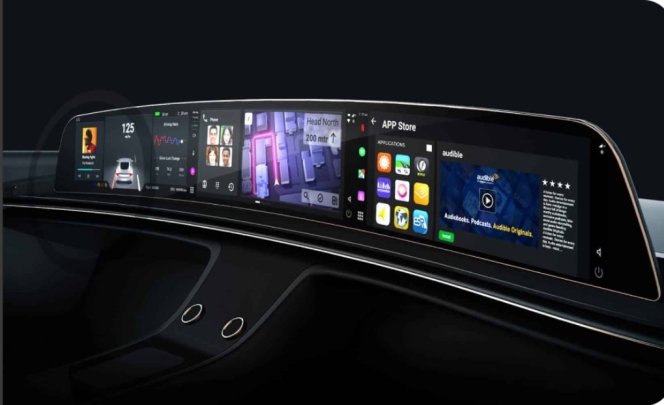
Visteon Corporation has announced an expanded technology partnership with Mahindra & Mahindra that will see its next-generation SmartCore Pro cockpit domain controller deployed in Mahindra’s XUV7X0 SUV lineup.
Unveiled at CES 2026, the SmartCore Pro builds on the SmartCore system introduced in the Mahindra XUV700 in 2021. The new system integrates cockpit electronics, surround view camera technology and telematics on Mahindra’s Adrenox+ platform. It features a three-display configuration supporting vehicle information, infotainment, ADAS visualisation and connectivity, alongside an integrated 360-degree camera system.
Francis Kim, Vice-President of Global Sales & Commercial Excellence and General Manager for Rest of Asia, Visteon, said, “The automotive industry is shifting from discrete systems to fully integrated digital platforms, and India is among the fastest-moving markets in this transition. This partnership demonstrates how strategic OEM collaboration can accelerate time-to-market for complex technologies while laying the foundation for software-defined vehicles.”
Alongside the Mahindra announcement, Visteon also showcased the production specifications and OEM implementations of its High-Performance Compute solution built on the Snapdragon Cockpit Elite platform. The solution follows Visteon’s collaboration with Qualcomm Technologies announced at Auto Shanghai 2025 and is now being demonstrated with multiple global OEMs.
The High-Performance Compute platform supports centralised vehicle architectures and software-defined vehicle strategies. It enables on-device AI processing, multi-display support, multi-user experiences and personalised cockpit features. The system uses the Qualcomm Oryon CPU, Qualcomm Adreno GPU and enhanced NPU AI performance, while Visteon’s cognitoAI Concierge digital assistant operates using the company’s QWEN 7B model.
Uday Dodla, Vice-President, Product Management, Visteon, said, “This High-Performance Compute solution addresses a critical challenge our OEM partners face as they transition to centralized architectures. By consolidating multiple ECUs into a single, powerful platform, we're enabling automakers to reduce complexity and costs while delivering the sophisticated AI-driven experiences that consumers increasingly expect.”
Mark Granger, VP, Product Management at Qualcomm Technologies, said, “Visteon's demonstration of its High-Performance Compute solution on the Snapdragon Cockpit Elite platform highlights the momentum toward centralized, software-defined architectures that will power the next era of intelligent, connected vehicles.”
Visteon said the platform is designed to support a common architecture across vehicle segments, allowing OEMs to scale features while consolidating electronic control units and supporting long-term cost efficiencies.
Valeo Join Forces With Hero MotoCorp To Bring ARAS Tech For Two-Wheelers
- By MT Bureau
- January 09, 2026
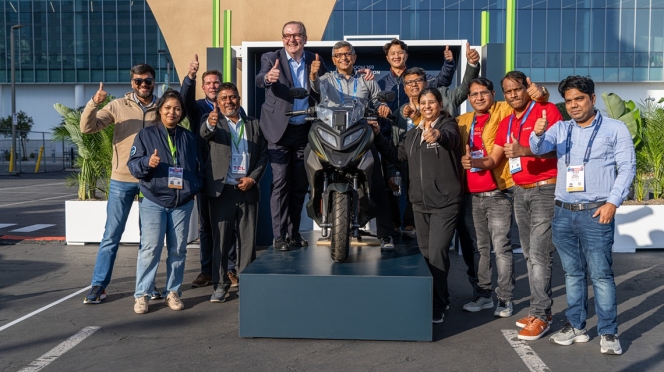
French tier 1 supplier Valeo and Hero MotoCorp, the world’s largest manufacturer of motorcycles and scooters, have inked a strategic partnership for Advanced Rider Assistance Systems (ARAS).
The partnership will focus on enhancing rider safety by introducing advanced sensing, perception and intelligent technologies tailored specifically for two-wheelers across both entry-level and premium segments, including the OEM’s emerging electric mobility portfolio under VIDA.
As part of the understanding, they will focus on ARAS by leveraging Valeo’s radar and smart camera tech equipped in Hero MotoCorp’s two-wheeler portfolio. This will not only enhance safety for two-wheeler users in India, but is also expected to drive awareness amongst customers globally.
The partners state that they have already achieved success in its proof-of-concept systems designed to protect both riders and pedestrians.
Marc Vrecko, CEO, Valeo’s Brain Division, said, “We are truly excited to partner with Hero MotoCorp to deliver solutions that will significantly enhance rider safety and create a more secure riding experience for millions of people. This collaboration is a key step in our strategy to bring advanced technology to the rapidly growing mobility market in India and globally.”
Ram Kuppuswamy, COO, Plant Operations, Hero MotoCorp, said, “At Hero MotoCorp, we are redefining the future of mobility by bringing advanced technology to our products. Our partnership with Valeo marks a significant stride in making mobility smarter, safer and more sustainable with next-gen advanced rider assistance systems. Together, we aim to make two-wheeler safety accessible to everyone and set new standards for innovation and protection globally.”
The ARAS architecture is developed as a digital co-pilot for riders, providing a 360deg safety envelope around the vehicle, it provides real-time sensing and intelligent alerts. It uses a radar-based system that can provide critical information/warnings such as Forward Collision Warning (FCW), Distance Warning (DW), Lane Change Assist (LCA), Blind Spot Detection (BSD) and Rear Collision Warning (RCW).
On the other hand, the vision system uses high-resolution cameras to provide Pedestrian Detection, Lane Detection, Traffic Sign Recognition and Lane Departure Warning.
Through intelligent image processing the system identifies road signs and obstacles, even in low-light conditions. Through the combination of radar and vision system, the two-wheeler encompasses a comprehensive safety system for two-wheeler users.
SiMa.ai And Synopsys Announce Integration To Accelerate Automotive AI Development
- By MT Bureau
- January 08, 2026
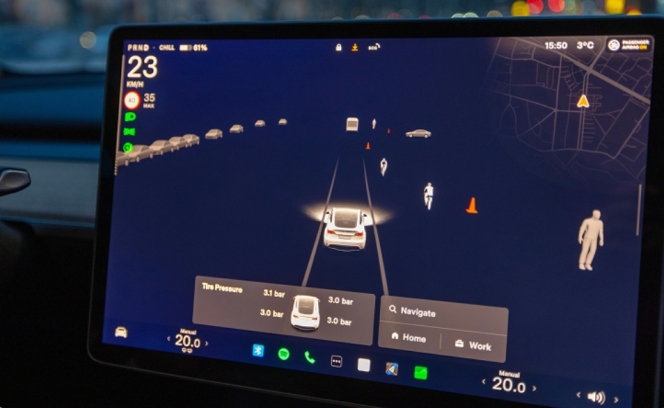
SiMa.ai has announced its first integrated capability resulting from a collaboration with Synopsys. The joint solution provides a blueprint to accelerate architecture exploration and virtual software development for automotive Systems-on-Chip (SoCs). These chips support applications including Advanced Driver Assistance Systems (ADAS) and In-Vehicle Infotainment (IVI).
The partnership aims to deliver architectures required for software-defined vehicles. The blueprint allows customers to begin the design and validation of custom AI SoCs and ‘shift left’ software development before silicon is available. This process is intended to reduce development costs and accelerate vehicle time-to-market.
The blueprint provides pre-integrated SoC virtual prototypes and a tool workflow using solutions from both companies.
For Architectural Exploration:
- SiMa.ai MLA Performance and Power Estimator (MPPE): Enables customers to size machine learning accelerator designs for specific workloads.
- Synopsys Platform Architect: Used to model workloads and analyse performance, power, memory, and interconnect trade-offs before RTL design.
For Verification and Validation:
- Synopsys Virtualiser Development Kit (VDK): Facilitates software development using a virtual SoC prototype, which can accelerate vehicle time-to-market by up to 12 months.
- SiMa.ai Palette SDK: Supports machine learning workflows for edge AI applications.
- Synopsys ZeBu Emulation: Delivers pre-silicon hardware and software validation to ensure architectures meet workload requirements.
Krishna Rangasayee, Founder & CEO at SiMa.ai, said, "We are pleased with how well the two teams have worked together to quickly create a joint solution uniquely focused on unlocking physical AI capabilities for today's software defined vehicles. Our best-in-class ML platform, combined with Synopsys' industry-leading automotive-grade IP and design automation software creates a powerful foundation for innovation across OEMs in autonomous driving and in-vehicle experiences."
Ravi Subramanian, Chief Product Management Officer, Synopsys, said, "Automotive OEMs need to deliver software-defined AI-enabled vehicles faster to market to drive differentiation, which requires early power optimisation and validation of the compute platform to reduce total cost of development and time to SOP. Our collaboration with SiMa.ai delivering an ML-enabled architecture exploration and software development blueprint supported by a comprehensive integrated suite of tools significantly jumpstarts these activities and enables our automotive customers to bring next-generation ADAS and IVI features to market faster."
Tianma Showcases Automotive Display Technologies At CES 2026
- By MT Bureau
- January 08, 2026
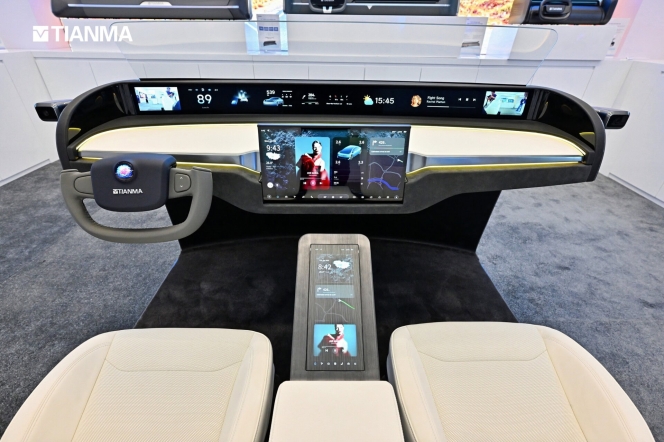
Chinese display panel manufacturer Tianma recently exhibited its range of automotive technologies at CES 2026. The company’s solutions include LTPS-LCD, AMOLED and MicroLED technologies designed for cockpits.
The centrepiece of the exhibit was the Smart Cockpit 7.0, an automotive interior and dashboard demonstration. It integrates a 49.6-inch curved ACRUS display with 8K resolution and a slidable AM-OLED display using a gear-rack mechanism.
It also presented InvisiVue, a solution that mimics decorative surfaces like wood or metal when inactive and reveals images through a transmissivity layer when powered on.
The 49.6-inch ACRUS curved display uses Corning ColdForm Technology. It features pixel-level dimming with 210,000 zones, achieving a contrast ratio of 100,000:1. The unit’s R3000 curvature is designed to align with the windshield to reduce blind spots and reflections.
Furthermore, Tianma also presented two HUD technologies – a 43.7-inch Ultra-wide IRIS HUD. It uses a Mini-LED display with peak brightness of 10,000 nits for visibility in sunlight. It features an 85 percent NTSC colour gamut and a curved structure designed to match the windshield’s optical path.
Secondly, an 11.98-inch IRIS HUD, which utilises high-luminance PGU technology, delivering 12,000 nits brightness. The module is less than 15 mm thick for integration in compact vehicles and operates at approximately 6 W to reduce thermal load.
The company also introduced a 34-inch dye liquid crystal dimming glass for rear side privacy windows. This technology uses voltage control of liquid crystal molecules to achieve stepless dimming without physical sunshades.
The system provides a response time of less than 300ms for transitions between privacy and transparent modes. It features a wide viewing angle and a grey-black tone to manage glare within the vehicle interior.


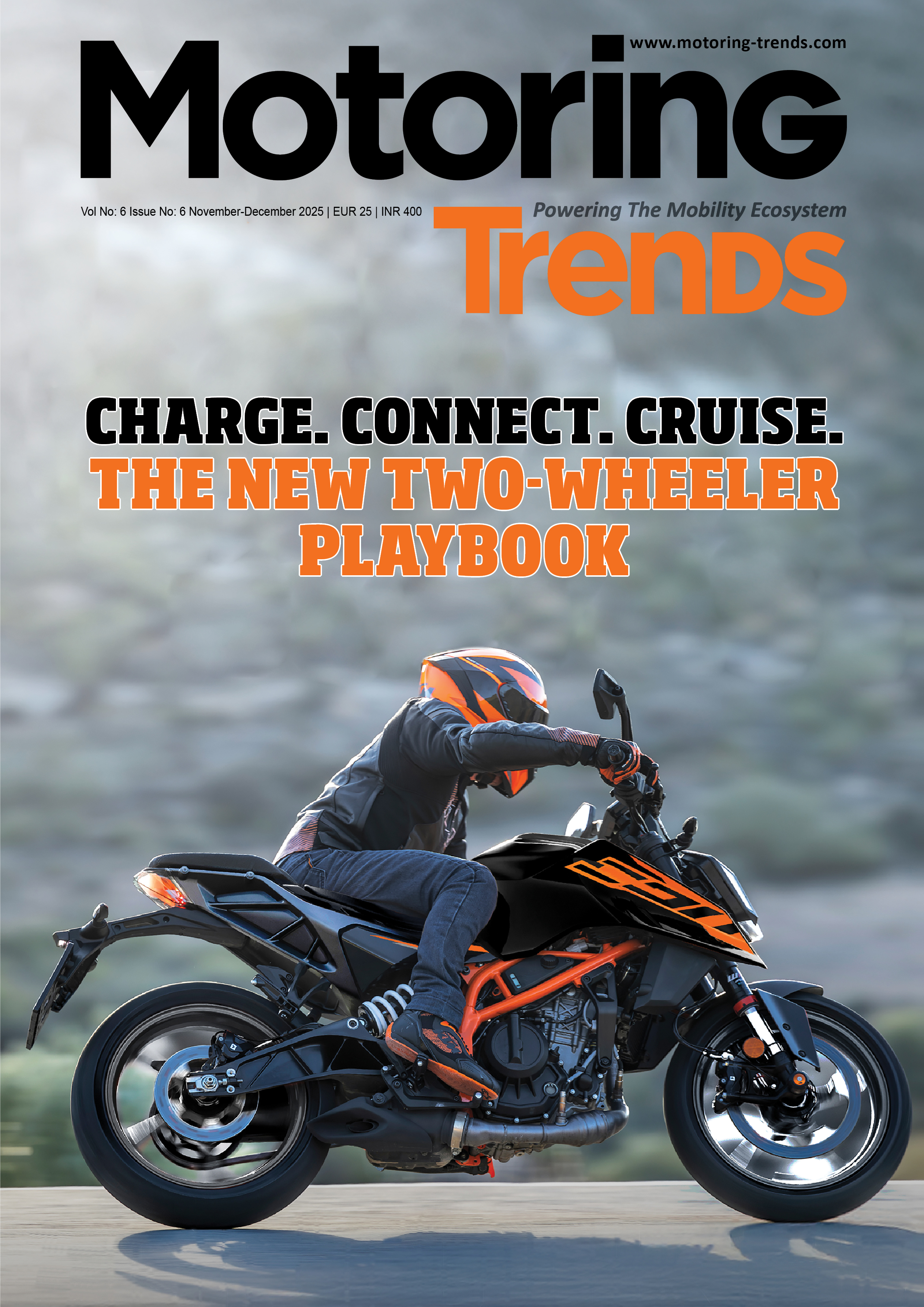




Comments (0)
ADD COMMENT